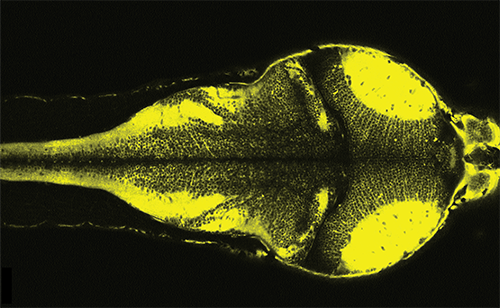_0.jpeg)
“We learn more about the brain every day,” said Abdelfattah, who joined Brown University in April as the Robert J. and Nancy D. Carney Assistant Professor of Neuroscience. “Our brain gives us unique abilities to think, learn, remember and perceive the world. I find that fascinating.”
Abdelfattah develops novel classes of light-responsive, genetically encoded tools for reading and modulating brain activity at the resolution of individual cells. His lab uses bioengineering and chemical approaches to develop molecular tools to visualize and study the brain. Researchers combine electrophysiology, fluorescence imaging, protein engineering and advanced genetic approaches to visualize the structure and function of the nervous system.
Shortly after joining Brown and the Carney Institute for Brain Science, Abdelfattah was named a 2021 Searle Scholar for creating optogenetic tools to record, trace and manipulate brain circuits at cellular resolution. He is one of 15 scientists nationwide to receive the $300,000 award, which will support his research at Brown for the next three years.

Abdelfattah completed his postdoctoral research at the Janelia Farm campus of the Howard Hughes Medical Institute where he engineered Voltron, a new class of chemigenetic fluorescent voltage indicators. Voltron, which is now used by hundreds of labs, enabled for the first time imaging of neural activity from dozens of living neurons simultaneously.
Abdelfattah recently took a break from the bench to discuss how he began developing molecular tools and his plans for creating new optogenetic tools to study brain activity.
Why did you start developing molecular tools to study how the brain works?
It started with my interest to engineer proteins to have new functions in the lab. Proteins are capable of amazing feats — they are the workhorses of life. In graduate school, I worked on turning fluorescent proteins from corals into calcium sensors that would change their fluorescence when calcium concentrations change. It turned out that these were, and are, very useful tools to image brain activity.
Coming from a biochemistry background, I was introduced to brain research through collaborators using our tools to image the brains of model organisms. Since then, I think about ways to develop tools needed to record brain processes that we just can’t measure with existing methods.
What brain function problems are you most interested in, and how do your tools help address those issues?
I’m interested in illuminating brain communication in general. Brain cells communicate using electrical and chemical signals. However, there isn’t a natural contrast mechanism that allows us to see those signals. I hope to use our new molecular tools to unravel the functional basis and causes of neural disorders at a level of detail that has not been accessible to date, and to empower us to develop novel treatments.
What new tools are you developing in your lab at Brown?
We are interested in developing new classes of optogenetic tools for large-scale functional analyses and manipulation of brain circuits. One set of tools will build on our recent report of engineered chemigenetic voltage sensors that extend voltage imaging to dozens of cells over tens of minutes in live animals. We will develop voltage sensors to enable recording activity of whole brain circuits deep inside the brain with bandwidth to visualize currently invisible signals like synaptic potentials. Another set of tools we are interested in engineering are light-gated proteins capable of transferring genetic payloads from one neuron to another to trace and manipulate brain circuits in live behaving animals.
Our lab believes in open science. We make our tools available to the broader neuroscience community. We build interdisciplinary collaborations with biologists and optical engineers to ensure these tools optimally meet cutting-edge needs. It is this feedback that makes us develop the right tools useful for real-world experiments that unlock new biological insights.
Are there aspects of Brown University and the Carney Institute that will be particularly helpful in advancing your work?
Brown and Carney are a unique and fun place to talk with like-minded people who are thinking about big problems in brain science. I hope to integrate into the community here and collaborate on making the right tools to advance brain research. I’m excited to be part of a great talent pool from many different disciplines — such as engineering, chemistry, physics and biology — focused on brain research.
Ahmed Abdelfattah received a B.S. in pharmacy and biotechnology from the German University in Cairo, Egypt, and a Ph.D. in chemistry from the University of Alberta in Canada where he worked on the development of fluorescent protein-based indicators for neuronal activity imaging. Abdelfattah was a Vanier Canada Scholar at the University of Alberta and recipient of the President’s Doctoral Prize of Distinction.